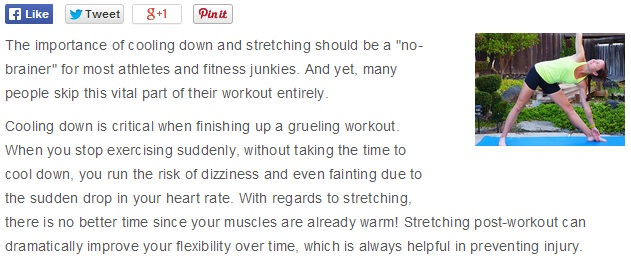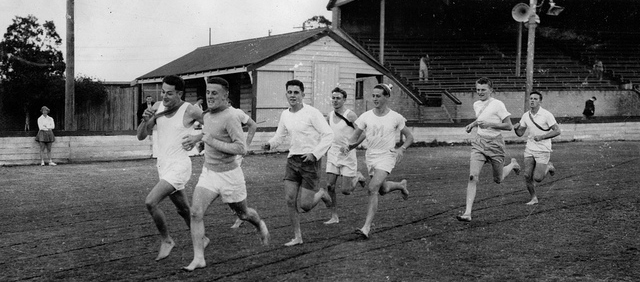Over the last several years, I’ve been on a mission to learn the most effective training for runners – so I can help runners like you race faster, get stronger, and stay healthy.
I received my coaching education from USA Track & Field – and earned a near perfect score on the test.
I’ve rigorously studied the best books and training programs (I own almost all of them and refer to them constantly).
I’ve interviewed and spoken with the brightest minds in the sport, asking them tough questions about what works, what doesn’t, and our biggest misconceptions about injuries.
But more importantly, I’ve tested the best training methods on thousands of athletes. The results speak for themselves.
What I’ve learned can certainly help you run fast. But maybe more importantly, it can help you stay healthy and run pain free.
And predictably, years of working with runners has shown that there are many misconceptions about injuries. Runners think they’re doing the right thing but are just making it worse, like:
- Stretching your Achilles when you have tendinopathy (ouch!)
- Taking a month off after ITBS (rest rarely works)
- Getting custom orthotics when plantar fasciitis strikes (why?!)
But it’s not our fault that we don’t know what to do. I spent a decade running with constant injuries thinking I was doing the right thing when I was totally wrong.
Thankfully, I’ve turned it all around – I haven’t had a serious injury since 2009. You can read my full injury story here.
The problem is that major running media sources don’t filter their content at all. So clueless writers publish material that is useless at best and downright dangerous at worst.
Today I want to share just a few examples of what I’ve found. I could give you a hundred but I’d rather focus on solutions rather than the problems. That’s why this entire month is focused on injury prevention (make sure you don’t miss anything by joining my injury prevention group here).
So here are three pieces of risky injury advice that are perpetuated by alleged experts that you should avoid like the plague. Seriously, this is real content that I found on the biggest running websites on the web.
Stretching is a No Brainer (or is it?)
Want to prevent injuries? And fainting (WTF)? Just stretch!

Here’s the truth: stretching does absolutely nothing in terms of injury prevention. Zip. Nada.
In a review of the existing scientific studies, Runner’s World columnist and exercise science writer Alex Hutchinson concluded the same thing in his book. He wrote:
“The Centers for Disease Control and Prevention reviewed 361 [studies] in 2004. ‘Stretching was not significantly associated with a reduction in total injuries,’ they concluded. Moreover, ‘use of stretching as a prevention tool against sports injury has been based on intuition and unsystematic observation rather than scientific evidence.’ Subsequent reviews, most recently in 2008, have reached the same conclusion.”
While “cooling down” is critical when finishing a hard workout, you’re best served by running easy and then completing a post-run core workout.
Not only is the act of stretching unhelpful in preventing injuries (plus it can actually lead to injuries if you stretch before running), but simply being flexible also has no influence on staying healthy.
Hutchinson writes:
“The weak link in the chain of logic is the assumption that being more flexible protects you from injury. Most muscle injuries occur within the normal range of movement… ‘If injuries usually occur within the normal range of motion,’ McGill University sports doctor Ian Shrier asked in a widely cited editorial in the British Journal of Sports Medicine in 2000, ‘why would an increased range of motion prevent injury?'”
The science is clear: you don’t need to stretch. Instead, get stronger.
How NOT to Run Intervals
A classic mistake I see most runners make is running too fast. It’s almost universal.
So when I see advice like this, my blood boils.

This is not a random person on Twitter. This is an editor of a major fitness magazine encouraging runners to run workouts at an intensity that likely has no relevance to their goal race. This advice is deeply flawed and showcases the author has no idea what the purpose of an “interval workout” actually is or what it accomplishes.
Intervals can be any distance or pace – like tempo or marathon pace. Or they can be at your mile race pace (really fast!) but only for 200 meters and with a full recovery. So that’s not very hard at all.
But this “expert” just encouraged over 5,000 people to run way too fast, with no context about pace, distance, when this workout should happen during the training cycle, or the recovery. How shameful.
And running too fast (especially “dying” for the rest period) is a huge injury risk.
Sigh…
Stay Healthy…By Not Running!
The best way to never get injured is to never run. But what runner wants to do that?
I laughed in despair when I saw this injury prevention “wisdom:”


Ugh. Is this really the “top” advice from running’s leading experts?
Running 3-4 days per week is not an adequate injury prevention method. It’s a surefire way to limit your performance, feel awkward on the days that you run (the more you run, the more efficient you become – which can prevent injuries!), and potentially never run another personal best.
And walking? C’mon, don’t bullshit me. Walking when you’re fatigued is a great way to run slower. When so many runners want to run an entire race, suggestions to walk more just keeps many runners down. Only a small minority of beginners should be taking walk breaks (I know; I’ve written plenty of run-walk plans for new runners).
But from an injury perspective, it’s virtually useless. There are far better ways to stay healthy that don’t have the side effect of making you slower.
Looking at this mainstream advice, it’s no wonder my inbox fills up with stories like these:
“I lost so much speed from being sidelined by injuries. Then I have to start over again. I would have qualified for Boston by now if I didn’t have to take so much time off. Plus, losing the mental release from running puts me in a deep depression.”
“Most of the time I knew an injury was coming, but still ran anyway hoping that it would eventually go away or because I was so tired of being injured and having to take it easy. Injuries are frustrating because once I target one injury and work on correcting/strengthening the area another one seems to pop up somewhere else, like I am always doing something wrong. And when I am not injured I am almost scared to train harder in fear of triggering another injury.”
“As a new runner I felt like I was constantly getting injured. It was frustrating not to be able to get on a schedule cause I was always taking days off. I felt like I was stuck in neutral, never improving.”
Let’s make sure this never happens to you.
What to Do Instead
Here’s my rapid fire advice column in response to these mainstream suggestions:
- You don’t have to do any static stretching. Instead, warm up with a dynamic stretching routine and finish with a light core or strength session.
- Run workouts at the appropriate pace based on your fitness level, purpose of the workout, and goal race. Workouts are not races.
- Running fewer days per week is counterproductive to running faster. And it reduces your efficiency and overall fitness level. Not recommended as a form of injury prevention.
- Walking is only necessary if you’re a total beginner and can’t complete the prescribed distance. But walk because you need it to finish the distance – not to reduce your injury risk.
While it’s important to do the right training and injury prevention work in your running program, it’s also important to avoid the wrong things. This article is designed to help you weed out the coaching advice that won’t help – so you can focus on what matters.
I have a new presentation for the runners on my injury prevention list about three specific times when you’re more likely to get hurt.
Injuries aren’t necessarily equal opportunity offenders. They often strike when you’re most vulnerable and I’m going to share when that is (so you can be extra careful).
If you’d like to get the presentation, just sign up here and I’ll send it to you.
Stay healthy and run strong!
